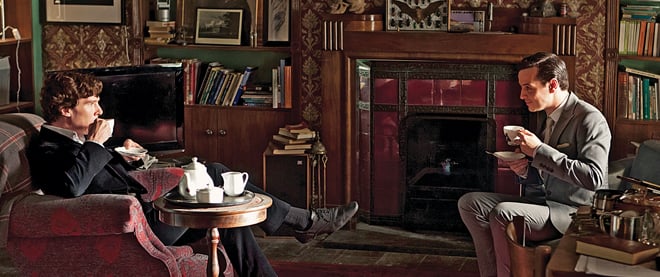‘Sherlock’s’ cliffhanger has viewers stumped
Only detective the great Mr. Holmes could figure it out. Trouble is, he’s supposed to be dead.
Share

In a series known for witty writing, breakneck plots and intricate crimes, the final episode of Sherlock’s second season stands out for a cliffhanger so baffling it has spawned a worldwide obsession. It wasn’t the ending itself—anyone familiar with the Arthur Conan Doyle story knew The Reichenbach Fall would conclude with the great detective’s “death”—but rather how the show pulled it off.
The finale, which aired last Sunday on PBS’s Masterpiece, has criminal mastermind Jim Moriarty convincing the tabloids, and thus the world, that Holmes wasn’t a brilliant detective but a fraud. Then, with Holmes’s reputation in tatters, Moriarty delivers the coup de grâce on a London rooftop: if snipers don’t get confirmation that Holmes has jumped to his death, they will kill his three closest friends, including Dr. John Watson. Viewers, and a horrified Watson watching from the street below, see him seemingly plunge to his death. Yet the very last frame of The Reichenbach Fall features Holmes, very much alive and in hiding.
Unlike Doyle’s 1893 original, in which no one finds the body after Holmes plummets to his death off Switzerland’s Reichenbach Falls, these modern aficionados of the detective were going to make sure everyone saw Holmes’s plunge and lifeless form. “It was plotted and planned from the beginning,” Steven Moffat explained, so as to be “something that invites people to speculate on how it happens.” He and co-creator Mark Gatiss succeeded. From the moment their work aired on the BBC in January, the Internet exploded in manic speculation. Why did Holmes want Watson to stand in that particular location? Did he throw a dummy over the edge? Was the body on the sidewalk a cadaver, made up to resemble the detective? Moffat egged them on. “There is a clue everybody’s missed. So many people theorizing about Sherlock’s death online—and they missed it,” he boasted in the Guardian.
Fans scoured the final scenes frame by frame, looking for clues. One was Amer Almomani, a 28-year-old Jordanian working at an IT firm in Saudi Arabia, who wanted to “see what things I could have missed that [could] help me crack the death thing.” After evaluating the theories on his Gradly.net blog, he believes Holmes survived by landing on a garbage truck that momentarily blocked the fall from Watson and viewers.
The speculation was only part of Sherlock’s social-media life. Using a quote from the show blog created for John Watson—“He was my best friend and I’ll always believe in him”—as a rallying cry, fans created “I believe in Sherlock” posters and flyers, with photographs uploaded to Tumblr.
For Sarah Marrs, 29, the Sherlock ending is even better than the most publicized cliffhanger of all: the “Who shot J.R.?” mystery on the TV soap Dallas. She’s confident Sherlock’s creators will satisfy fans with a better conclusion than Dallas’s notoriously weak one (J.R. was shot by a minor character, his lover/sister-in-law Kristin). “It’s probably very simple and pretty obvious,” says Marrs, the Chicago-based creator of the Cinesnark blog. For that reason Marrs won’t pick a theory. “We’re trying to outguess Sherlock Holmes, and that’s not going to happen.”
What makes this cliffhanger stand out is the long wait for answers. With Benedict Cumberbatch (Holmes) busy with a new Star Trek film and Martin Freeman (Watson) tied up with The Hobbit, the next three episodes won’t air until 2013. “I think that’s a huge part of why this is the cliffhanger from hell,” Marrs complains. And Moffat is notorious for false trails. “I’m under no obligation to tell the truth,” he warns. “I lie because I keep secrets.”
Though the sequences that reveal how Sherlock Holmes survived were filmed at the same time as the cliffhanger, the participants remain mum. All Rebecca Eaton, executive producer of Masterpiece, which co-produced Sherlock, will acknowledge is that “there is definitely a clue” in the final episode. Moffat says everything needed to solve the cliffhanger has been seen by viewers and promises the result will be worthy of the world’s only consulting detective. “It’s not a cheat. It all makes sense.” This time he better be telling the truth.